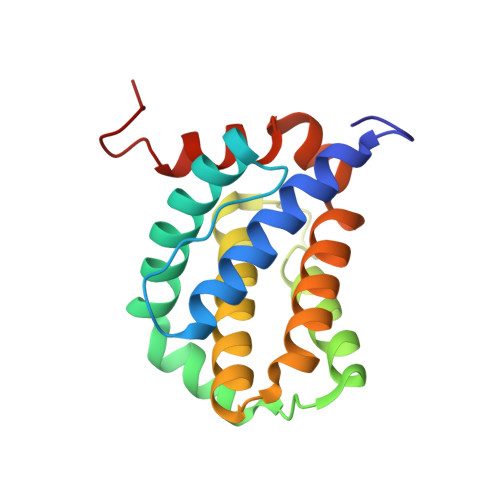Structure of the BH3 Domains from the p53-Inducible BH3-Only Proteins Noxa and Puma in Complex with Mcl-1
Day, C.L., Smits, C., Fan, F.C., Lee, E.F., Fairlie, W.D., Hinds, M.G.(2008) J Mol Biol 380: 958-971
- PubMed: 18589438
- DOI: https://doi.org/10.1016/j.jmb.2008.05.071
- Primary Citation of Related Structures:
2ROC, 2ROD - PubMed Abstract:
Pro-survival proteins in the B-cell lymphoma-2 (Bcl-2) family have a defined specificity profile for their cell death-inducing BH3-only antagonists. Solution structures of myeloid cell leukaemia-1 (Mcl-1) in complex with the BH3 domains from Noxa and Puma, two proteins regulated by the tumour suppressor p53, show that they bind as amphipathic alpha-helices in the same hydrophobic groove of Mcl-1, using conserved residues for binding. Thermodynamic parameters for the interaction of Noxa, Puma and the related BH3 domains of Bmf, Bim, Bid and Bak with Mcl-1 were determined by calorimetry. These unstructured BH3 domains bind Mcl-1 with affinities that span 3 orders of magnitude, and binding is an enthalpically driven and entropy-enthalpy-compensated process. Alanine scanning analysis of Noxa demonstrated that only a subset of residues is required for interaction with Mcl-1, and these residues are localised to a short highly conserved sequence motif that defines the BH3 domain. Chemical shift mapping of Mcl-1:BH3 complexes showed that Mcl-1 engages all BH3 ligands in a similar way and that, in addition to changes in the immediate vicinity of the binding site, small molecule-wide structural adjustments accommodate ligand binding. Our studies show that unstructured peptides, such as the BH3 domains, behave like their structured counterparts and can bind tightly and selectively in an enthalpically driven process.
Organizational Affiliation:
Department of Biochemistry, University of Otago, Dunedin 9054, New Zealand.















